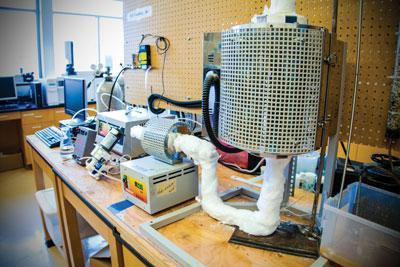
Research equipment at the SDSM&T (Credit: SDSM&T)
Hydrogen fuel is a zero-emission fuel that can potentially be mass-produced and commercialized for passenger vehicles and aircraft. However since pure hydrogen does not occur naturally, it takes energy to manufacture it. Most currently available hydrogen production processes are either costly or too complex or negatively affect the environment. Scientists from the South Dakota School of Mines and Technology are studying a new way to produce hydrogen on a large scale.
H2O. It is perhaps the most well-known, earliest-taught chemical formula in the universe. Chances are even the least scientifically-minded person knows that H2O is water. Two hydrogen atoms + one oxygen atom = one water molecule. What if scientists could take a water molecule’s two hydrogen atoms and turn them into four hydrogen atoms? Check. What about taking those four and making eight? Check. Those eight into …
Finding a way to exponentially double the hydrogen atoms to create a sustainable amount of hydrogen regeneration so that a new form of energy can be harvested is the ultimate goal of researchers at the South Dakota School of Mines & Technology. Rajesh Shende, Ph.D., and Jan Puszynski, Ph.D., of the Department of Chemical and Biological Engineering, have been awarded a $299,975 National Science Foundation three-year grant to test high-temperature water splitting in multiple thermochemical cycles.
Using thermally-stabilized redox materials, particularly ferrites, already the team has documented reliable multiple-cycle results, sparking hope that sustainable hydrogen energy through the use of thermal hydro-splitting will one day be feasible, says Shende.
Just two other U.S. locations, and possibly a third, are conducting similar research, according to Shende. One of the aspects that makes the Mines experiments unique is that the group has successfully split water molecules during multiple cycles at significantly lower temperatures than other documented research efforts. While others have demonstrated thermochemical splitting of the water molecule at 800-1500 degrees Celsius, the School of Mines has documented multiple cycles at 700-1100 degrees Celsius, which could potentially lead to a more affordable large-scale effort. “In industry this will be more appealing,” says Shende, who is filing an invention disclosure and who has published his findings in scientific magazines.
Higher temperatures normally cause particles to grow so large that hydrogen levels drop, causing very little hydrogen regeneration. The School of Mines experimental studies look to stabilize the hydrogen levels, enhancing knowledge of the physical and chemical processes involved in thermal stabilization of redox materials’ morphologies without deterioration of complex ferrites. “Others might be splitting water by other methods, but there has to be a lot of novelty to get funded,” says Shende, who built a fully instrumented reactor in his campus laboratory.

